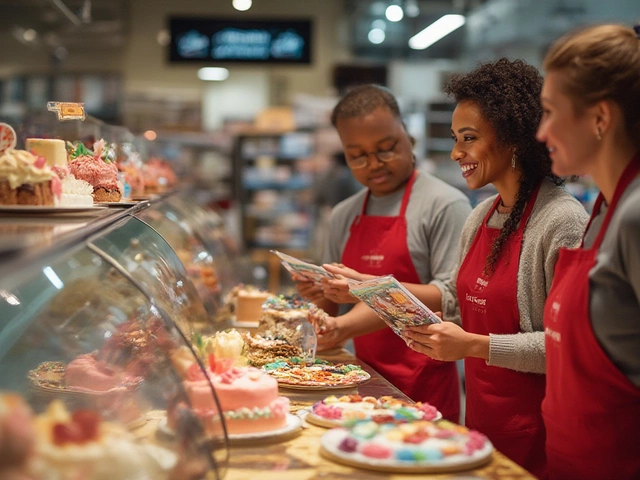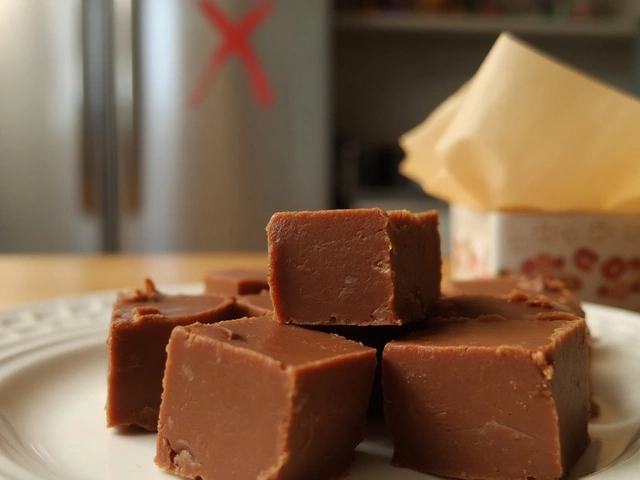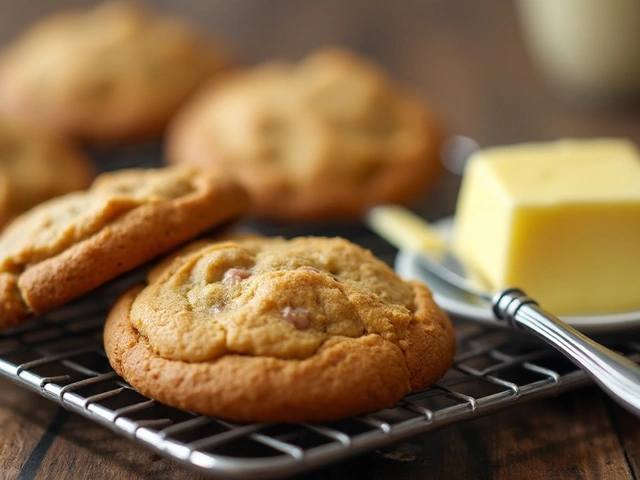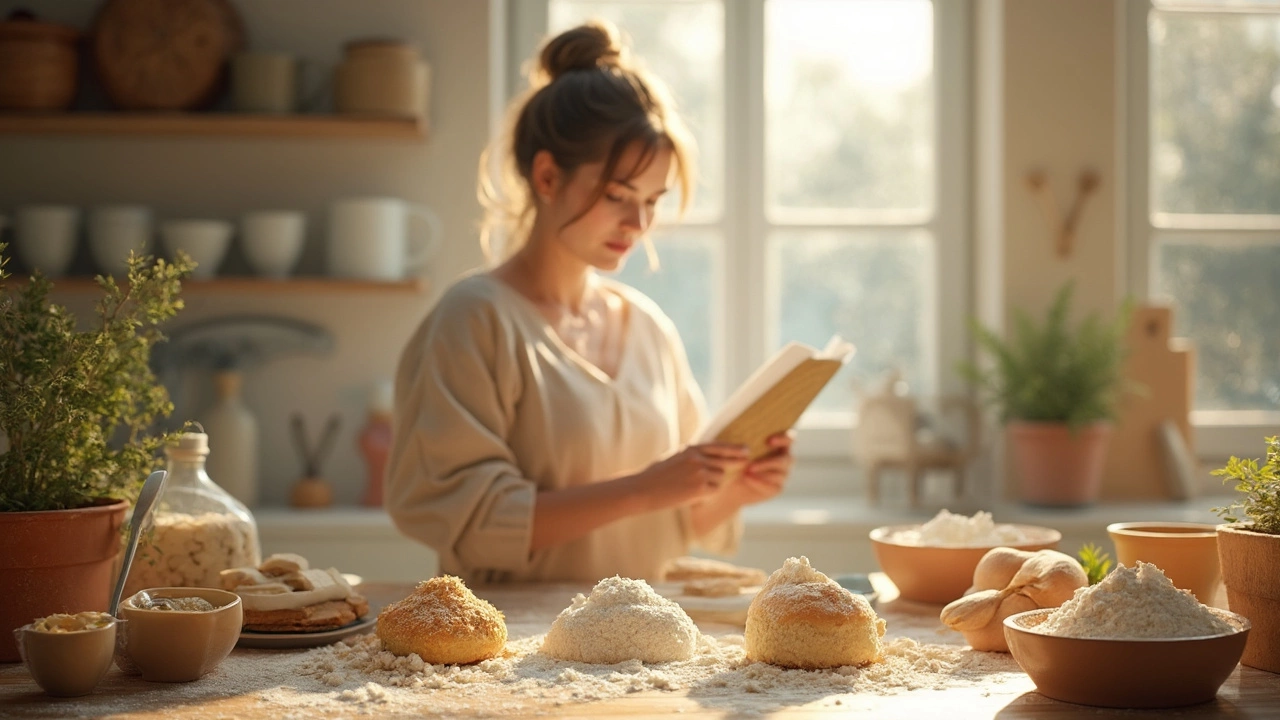
If you’re switching to gluten-free baking, it’s easy to grab a bag of “gluten-free flour” and expect everything to turn out the same as regular cake. But that’s usually where things go sideways. Not all gluten-free flours work as a one-to-one swap, and some even sneak in wheat-based fillers. Always check ingredient labels—words like "malt" or "modified food starch" can hide gluten in plain sight.
One of the biggest dangers is cross-contamination. Did you know even tiny crumbs from regular bread or flour can make a gluten-free cake unsafe? If your spatula, mixer, or countertop isn’t totally clean, it’s all too easy to ruin the whole batch. A good trick: Keep separate baking tools for gluten-free recipes. Don’t forget to store your GF flours in sealed containers, away from the regular stuff.
- Misleading Ingredients and Cross-Contamination
- Flour Mistakes That Ruin Cakes
- Forgetting Binders and Leaveners
- Overbaking and Texture Issues
- Hidden Pitfalls in Flavor and Add-Ins
Misleading Ingredients and Cross-Contamination
Hidden gluten is everywhere, especially in baking mixes, flavorings, and even things like baking powder if it’s not certified gluten-free. You can’t just trust a label that says “wheat-free” either—that’s not the same as gluten-free. Wheat is a major gluten source, but barley and rye matter too, and sometimes manufacturers aren’t clear about the details. If you see “malt,” “spelt,” or “triticale” on ingredients lists, that’s gluten territory. And once, a popular store brand gluten-free flour actually tested positive for traces of wheat in multiple batches. That’s why you want to double-check for certified gluten-free labeling or, even better, brands with strong third-party testing.
The risk doesn't stop with ingredients. Gluten-free baking can go wrong because of cross-contamination, which happens more than people think. Maybe you’re scooping sugar from a container that had a flour-covered spoon in it a day before, or using a baking pan that caught regular cake crumbs last weekend. Even a little bit of leftover flour dust can make a difference for anyone who’s sensitive.
- Use separate utensils, bowls, and baking pans for gluten-free recipes.
- Thoroughly clean kitchen counters before baking.
- Store GF flours and mixes in tightly sealed containers, on shelves above any standard baking ingredients.
- Avoid wooden spoons—they hold onto gluten even after a good wash.
Statistics from a 2023 survey in the U.S. showed that 32% of people on a gluten-free diet reported symptoms after eating “gluten-free” baked goods—most cases traced back to some kind of cross-contamination or mislabeling.
| Hidden Gluten Source | Common Products |
|---|---|
| Modified Food Starch | Baking powders, cake mixes |
| Malt (barley) | Chocolate, flavorings, syrups |
| Spices with Fillers | Chai blends, cinnamon sugar, nutmeg mixes |
| Oats (not certified GF) | Breakfast cakes, snack bars |
Bottom line: just because something looks gluten-free doesn’t make it safe. Taking these precautions is the only way to keep your cakes truly safe and tasty.
Flour Mistakes That Ruin Cakes
Grabbing the first bag of gluten-free flour from the shelf isn’t the answer—there’s a lot more to think about. Not all gluten-free flours behave the same. Some, like coconut flour or almond flour, soak up way more moisture than others, making the cake dry and crumbly. If you use only rice flour, you’ll likely end up with a gritty texture nobody enjoys.
The best gluten-free cakes use blends instead of single flours. Why? Each flour brings something different: brown rice flour helps with structure, tapioca adds chew, and potato starch keeps things soft. Most store-bought blends try to mimic regular flour, but check the label—look for a mix of at least two or three flours and a starch. If there’s only one ingredient, don’t expect a great cake.
Using too much or too little flour throws everything off. Gluten-free flours pack down more than wheat flour, so if you scoop with the measuring cup, you could add up to 30% more flour than needed. Spoon the flour into the cup and level it off. No tapping or shaking.
Here’s a quick look at common gluten-free flours used in cakes, and what happens if you rely on just one:
| Flour Type | Texture | Flavor | Common Pitfall |
|---|---|---|---|
| Rice Flour | Gritty | Neutral | Dry, sandy cakes |
| Almond Flour | Moist | Nutty | Sinks, greasy texture |
| Coconut Flour | Very dry | Sweet | Cakes crumble apart |
| Sorghum Flour | Soft | Earthy | Dense if alone |
| Pre-mixed Blend | Balanced | Neutral | Varies by brand |
One more rookie move: skipping xanthan gum or psyllium husk. Those don’t sound fun, but they help your cakes hold together and avoid that sad pile of crumbs. Some gluten-free flour blends have it already—if not, you’ll need to add around a half teaspoon per cup of flour for cakes.
If you’re making your own blend, keep it simple. Try a basic mix of 40% whole grain flour (like brown rice or sorghum), 60% starches (tapioca and potato), and add a pinch of xanthan gum. You’ll be surprised how much better your cakes turn out.

Forgetting Binders and Leaveners
If you’ve ever wondered why a gluten-free cake falls apart or feels dense, you’re likely missing the magic of binders and leaveners. Wheat flour naturally holds traditional cakes together, but most gluten-free flours—like rice or almond—just don’t have that stickiness built in. That’s why skipping binders is one of the fastest ways to ruin a gluten-free recipe.
Binders are the fix for that crumbly texture. The most popular are xanthan gum and guar gum. These ingredients may sound odd, but adding even a tiny amount (usually ½–1 teaspoon per cup of flour) can transform a pile of crumbs into something you actually want to eat. Some gluten-free blends include them already, but always double-check or your cake can end up with a gritty bite. For an egg-free twist, people also use ground flaxseed or chia seeds with a bit of water for a gel-like effect.
Then there’s the problem of getting your cakes fluffy. Without gluten’s stretchiness, you need the right leaveners. Baking powder and baking soda are your go-tos. A common mishap is accidentally using double-acting baking powder (which can taste bitter in large amounts) or forgetting to increase it, since gluten-free batters are heavier than classic cake mixes. Even a tablespoon of lemon juice or a dash of vinegar can help boost the rise when used with baking soda. Here’s a handy breakdown of some common ingredients and their usual amounts:
| Ingredient | Purpose | Typical Amount (per cup of flour) |
|---|---|---|
| Xanthan/Guar Gum | Binder | 1/2–1 tsp |
| Flaxseed/Chia Gel | Binder (egg replacement) | 1 tbsp seeds + 3 tbsp water |
| Baking Powder | Leavener | 1–1.5 tsp |
| Baking Soda | Leavener | 1/4–1/2 tsp (& a sour ingredient like lemon juice) |
Always double-check your recipe for these helpers. Without them, even the best gluten-free flour mix can leave you with cakes that fall flat—literally and taste-wise. Don’t be afraid to experiment, but start slow: too much gum can make things chewy, and too much leavener can make cakes collapse. Play with small adjustments and you’ll get that perfect, cake-like bite.
Overbaking and Texture Issues
Dry, chalky, or crumbly cakes are the classic gluten-free struggle. The main culprit? Overbaking. Gluten-free cakes cook fast because gluten-free flours don’t hold moisture the way wheat does. Set your timer a few minutes early and use the toothpick test—but pull the cake out when there are a few moist crumbs, not when the stick is bone dry.
Texture is another big headache. Starches like rice flour or potato starch are popular for gluten-free baking, but they suck up more liquid than regular flour. If your batter seems thicker than what you’re used to, that’s normal, but don’t be tempted to keep adding flour. Extra flour just makes the cake dense and dry. For best results, use recipes designed specifically for gluten-free flours instead of just swapping them into old favorites.
If you like geeky details, gluten-free cakes can lose up to 14% of their moisture in the oven—compared to 9% for regular cakes. That extra loss explains why a cake that looks perfect for a minute can turn dry as it cools. Here’s a quick way to see how big an impact this makes:
| Cake Type | Average Moisture Loss (%) |
|---|---|
| Regular Cake | 9% |
| Gluten-Free Cake | 14% |
Another good tip: try using applesauce, mashed banana, or yogurt in your batter. These help lock in the moisture. Just don’t go overboard, or your cake can go from dry to gummy.
"Don’t rely on color alone—gluten-free cakes don’t brown the same way as wheat cakes. Internal temperature is your friend; aim for 205-210°F (96-99°C) for most gluten-free bakes." — America’s Test Kitchen
If you’ve struggled with dry gluten-free cakes before, you’re not alone. Stick with tested recipes, watch your bake time, and use moisture-boosters, and you’ll be on your way to something tender and tasty instead of a cake that doubles as a doorstop.
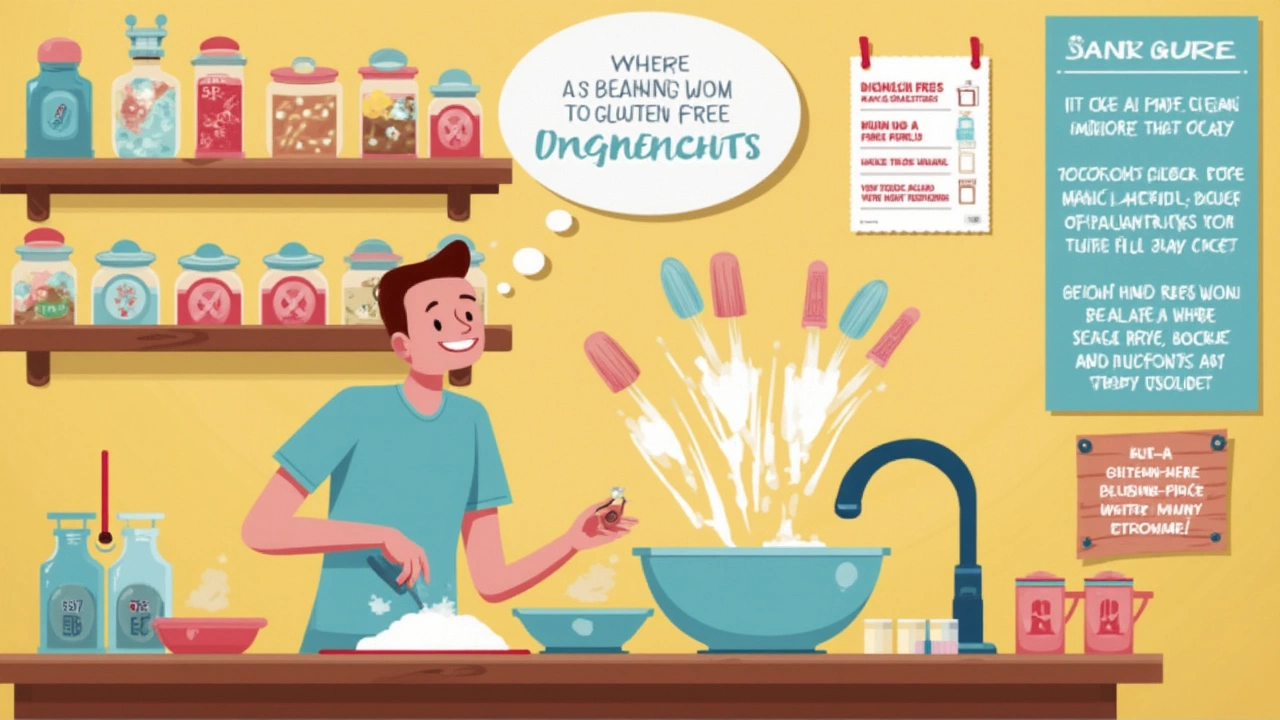
Hidden Pitfalls in Flavor and Add-Ins
Even if you get the main recipe right, flavor and mix-ins can throw off your entire gluten-free cake. Some baking powders and vanilla extracts actually contain gluten, which is wild when you’d never expect it. Always pick brands labeled gluten-free, especially for extracts, chocolate chips, and even sprinkles. Think your favorite nut topping is safe? Many nut mixes are processed in facilities with wheat, and that’s enough to trigger issues for people with celiac.
Mix-ins like dried fruit and candy add color but can sneak in wheat or get dusted with flour to stop sticking. For example, a 2023 survey from Beyond Celiac found that about 38% of popular dried fruit brands had possible cross-contamination with gluten—even if it wasn’t clear on the original packaging. If you’re buying packaged add-ins, always check the allergen statements and stick to simple, single-ingredient options if you’re not sure.
Flavor can also be a struggle because some gluten-free flours have strong tastes—they can turn your cake bitter or weirdly earthy. Sorghum, buckwheat, and some bean-based flours are famous for this. If you must use them, balance with extra vanilla or a splash of citrus zest to keep the flavor bright. Here’s a quick guide for add-in choices and flavor tips:
- Chocolate Chips: Check that they’re certified gluten-free, as some brands add barley malt.
- Nuts: Buy raw and roast them yourself to avoid cross-contamination.
- Dried Fruit: Rinse well and check labels for wheat flour or starch additives.
- Extracts: Choose pure vanilla extract, not imitation unless it’s labeled gluten-free.
- Spices: Spices can get mixed with flour in processing plants. Buy from trusted brands and check batch info online if you’re unsure.
Sometimes people water down flavors to hide the taste of gluten-free flours, but that just gives you bland cake. A little extra salt or a dash more vanilla actually brings out sweetness and can make gluten-free cakes taste way more like their regular counterparts.
| Add-In | Hidden Gluten Risk (%) | Safe Practice |
|---|---|---|
| Dried Fruit | 38 | Check for certified gluten-free label |
| Chocolate Chips | 22 | Read ingredient and allergen lists closely |
| Mixed Nuts | 31 | Buy raw/whole and roast yourself |
| Spices | 15 | Choose top brands, review batch info |
Nailing gluten-free flavor is about picking the right products and reading every label like your peace of mind depends on it—because if you’re baking for someone with celiac, it actually does.


